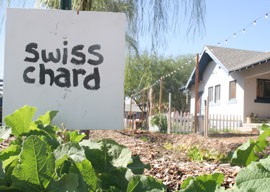Cronkite News has moved to a new home at cronkitenews.azpbs.org. Use this site to search archives from 2011 to May 2015. You can search the new site for current stories.
Getting their fingers dirty: Groups promoting local community gardens
Kenny Barrett kneels to show a guest some highlights of this garden: flashy trout’s back lettuce, Red Russian kale, arugula, three types of beets and a popular Mediterranean vegetable.
“That’s Swiss chard. I love growing Swiss chard, because it has this really vibrant color,” Kenny Barrett said. “You can grow it in reds, yellows, oranges … it’s just really beautiful.”
The garden produces anywhere from 200 to 400 pounds of vegetables in a given season, enough to feed a city block.
Perhaps it’s fitting, then, that the garden Barrett oversees lies within a city block.
Barrett has been working on Roosevelt Growhouse, part of the nonprofit Roosevelt Row Community Development Corp., for four years. The plot is a collective gardening site, or community garden, that allows volunteers to select an available plot and grow whatever they like.
“It beautifies the space,” said Barrett, programs manager for the nonprofit. “This used to be a vacant lot.”
The recent growth in locally grown food, exemplified by the community gardening movement, is a result of tough times in recent years, said Doreen Pollack, executive director of Valley Permaculture.
“We think a lot of it has been because of a change in the economy and the change in food quality,” said Pollack, who is also a master gardener. “Over the last couple years there has been so much more news about E. coli breakouts in food and food recalls than ever before.”
Community gardening offers a path for people to grow their own quality food and give back to the community through the excess produce, she said.
Chris Wharton, senior sustainability scientist for Arizona State University’s Global Institute of Sustainability, said there are three main obstacles to overcome in creating community garden: finding the land, paying for and distributing water and finding the time needed to tend it.
“With whole foods people have to cook more, prep more and take the time to do that which people are no longer accustomed to,” said Wharton, who also is an associate professor in ASU’s School of Nutrition and Health Promotion. “Then you add on to that the time it takes to go and cultivate the garden and maintain it over time.”
To help make it easier to manage community gardens, Valley Permaculture provides technical support, classes and regular meetings to keep garden managers connected.
“It’s more than just what do you plant,” Pollack said. “It’s really about how to organize yourself, how do you create leadership, how do create the ongoing resources that will keep your garden growing way beyond just planting in the ground.”
Wharton at a minimum at least half of the vegetables a family needs can be met by a decent-sized, well-maintained garden.
As for Kenny Barrett of Roosevelt Growhouse, the incentive is much more visceral.
“Once a week I get to go outside and get my hands dirty, be in the sun and just let all of the social media and all of the information that is coming in and out of my head constantly … it stops, for that period, once a week every week,” he said. “And I feel like it truly keeps me sane.”









